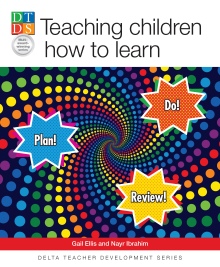Teaching children how to learn. Plan! Do! Review! by Gail Ellis and Nayr Ibrahim
Michael Berman, UK
FORTHCOMING JUNE 2015!

Learning to learn has always been an important aim of curricula throughout the world, but has often remained at the more theoretical level in official documents, due to a lack of practical guidelines for teachers on how to implement it.
Teaching children how to learn addresses learning to learn at a practical level, and will help you meet the diverse learning needs of children by equipping them from an early age with the critical learning skills required to meet the many social, economic and technological changes of the new century, and to foster lifelong learning and creativity.
Part A – PLAN!
- Presents the theoretical and methodological concepts of learning how to learn.
- Elaborates a framework of teaching principles for planning how to implement learning to learn systematically and explicitly.
- Goes down the path towards creating optimum teaching and learning conditions.
- Introduces the character of Wilbur the Worm, who will accompany both teachers and learners on their journey.
- Involves the home in the school activities.
Part B – DO!
- Provides a bank of activities for teachers to try out in their own classrooms.
- Structures the classroom activities around the routine of ‘Plan, Do, Review’.
- Suggests a further element – ‘Share’ – to foster home and family involvement in the learning process.
- Provides teachers with models which enable them to help the children learn how to learn.
- Develops teachers’ competence so they will be able to apply the routine to activities of their own
Part C – REVIEW!
- Contains additional ideas and interactive activities to assist teachers in their personal and professional development.
- Relates the principles from Part A more closely to teachers’ individual teaching situations.
- Encourages teachers to review and reflect on their classroom practice, their teaching strategies and their self assessment.
- Helps teachers to become successful teachers of children who are successfully learning how to learn.
Wilbur’s toolkit
- The friendly mascot, Wilbur the Worm, interacts with the children throughout Part B in a variety of ways to make learning to learn enjoyable, and guides them in their learning activities.
- The toolkit contains a bank of activity templates corresponding to Part B. The toolkit will be reproduced in convenient downloadable A4 format on the Teaching children how to learn page on the Delta website, which also includes extra resources – Activity Records for the children’s English Language Portfolios, and synopses of all the storybooks that Wilbur recommends in Part B.
Teachers’ toolkit
- The toolkit contains all the information needed for the teachers to carry out and assess the reflection and developmental activities in Part C.
- It provides all the necessary Keys, Comments and Transcription notes.
- The toolkit will be reproduced in downloadable A4 format on the Teaching children how to learn page on the Delta website, and includes the relevant templates corresponding to Part C.

Please check the Methodology & Language for Kindergarten Teachers course at Pilgrims website.
Please check the Methodology & Language for Primary Teachers course at Pilgrims website.


|